Tips and Tricks: The Right Way To Think About Doing Hair As An Artist
In this quick article, I'm gonna cover the concepts of creating hair. Whether it be sculpture, grooming or real-time hair cards.
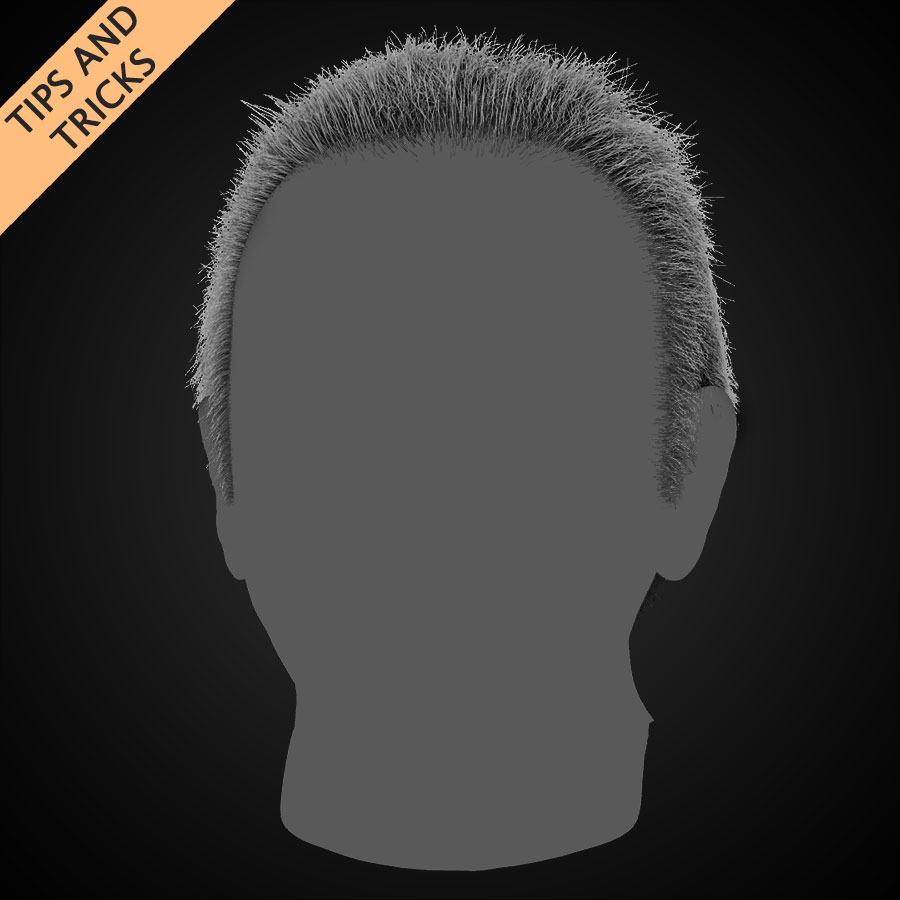
Doing hair -regardless of the art type- has always been an interesting topic to talk about among artists; due to its daunting challenges on the way. No matter what type of 3D hair you’re creating (real-time, rendered or sculpted), the way of thinking about it, the concept, is the same.
Let me make it clear at this point that if you’re looking for quality output, there’s no fast ways around it, you have to be patient and spend your time, deal with it.
Now, I’m not gonna write any step-by-step guides, because you can find loads of them on Google, and good ones, too. However, I’m here to talk about how to catch a fish, rather than giving you only one fish.
This article is written because one of my Reddit subscribers asked me about some explanations on doing hair. Due to the loads of work and lack of time, I couldn’t create the images of this article myself. So the images shown in the context (not the header though), are other artists’ works and I have no claims on them.
An Artist-Friendly Approach To Sculpt/Groom Hair
The basic idea, is to think of it as a sculpting process. Meaning that you have to do the Primary Forms first, then nail down the Secondary Shapes and finally the Tertiary Details. I’m gonna explain about each one and how to figure out each pass. As I said before, it doesn’t matter what sort of 3D hair you’re creating. This way of thinking, applies to all.
Primary Forms
The primary forms, are the first step (after gathering and studying references which I’m gonna talk about in the end) of doing hair. If you ask about a clearer definition, I’ll put it this way: “The Primary Forms of hair, are the ones which define the overall volume of the hair, and the general silhouette (forget about the tiny fly-away hairs for now). The ones that are recognized by the audience if your character is in the darkness and there’s some light behind.”
The goal of this pass, is simply to cover most of the head and let no scalp skin be visible. Besides, to show the general recognizable hairstyle.
-
If you’re doing real-time hair, you’re gonna need a texture sheet that does have some thick groups of hair, so that it let almost no light through and cover the scalp skin. You can read more about creating game hair texture sheet, here.
-
If you’re using hair-groomers like XGen, it’s the same; depending on your desired hairstyle, you’ll need at least one separate description to cover the head and shape the general silhouette.
-
If you’re sculpting hair, it’s still the same; you have to somewhat forget about details and nail down the primary shapes.
 This image above is a good example of primary forms of hair. By Adam Skutt
This image above is a good example of primary forms of hair. By Adam Skutt
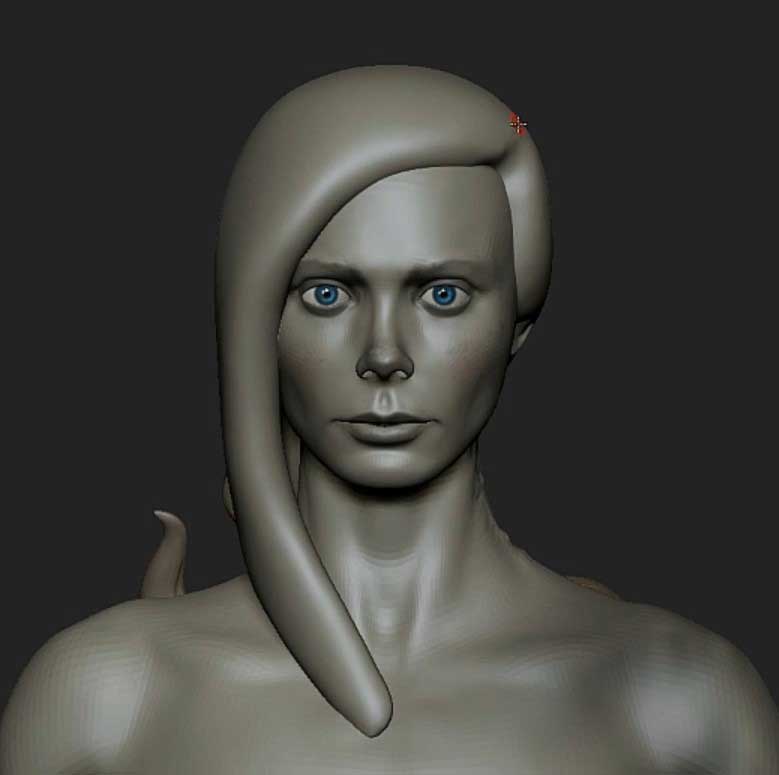 This one’s pretty basic. Obviously, there will be a lot more tweaking along the way. By Henning Sanden
This one’s pretty basic. Obviously, there will be a lot more tweaking along the way. By Henning Sanden
Secondary Shapes
The Secondary Shapes, live inside the Primary Forms. At this stage, you’re gonna add a bit more definition on top of what you had before. To put it in a nutshell, take one of your references on Photoshop and blur it. See those lines?! They’re the Secondary Shapes.
 By Henning Sanden
By Henning Sanden
However, if you ask about the definition, I’ll reply: “The Secondary Shapes, are the ones that include hair breakups and the connectivity or the flow of the hair. They’re made of smaller strokes than the Primary Forms, and bigger ones than the Tertiary Details. They’re groups of hairs that are related to each other in a smooth flow.”
The goal of this pass, is to define the general flow of the hair, add a bit more detail to the silhouette and add color variations as well. This is where most of the fight-throughs happen as an artist. If you have this pass done, and blurred it in Photoshop and it still worked, you’re on the right track.
Just have this mind, that this pass should define big[ger] chunks of hair. Leave the tiny details to the final step. Don’t be obsessed with details too much for now. Try to focus on how those big chunks of hair are connected/related to each other, as this is a very vital step in the whole process.
-
If you’re doing real-time hair, you need a texture sheet with a few hair groups consisted of mid to low counts of hairs. Also you can add a bit more color variations to them. You can read more about creating game hair texture sheet, here.
-
If you’re using hair-groomers like XGen, you may need to add a few descriptions depending on the hairstyle, and also use modifiers like Clumping in a more visible, meaningful way.
-
If you’re sculpting, the procedure is the same. Since you’re doing it by hand, you have to pay more attention to the relationship of the hair chunks. Also, it’s easy to find yourself wasting your time on details too soon! Just… stay focused!
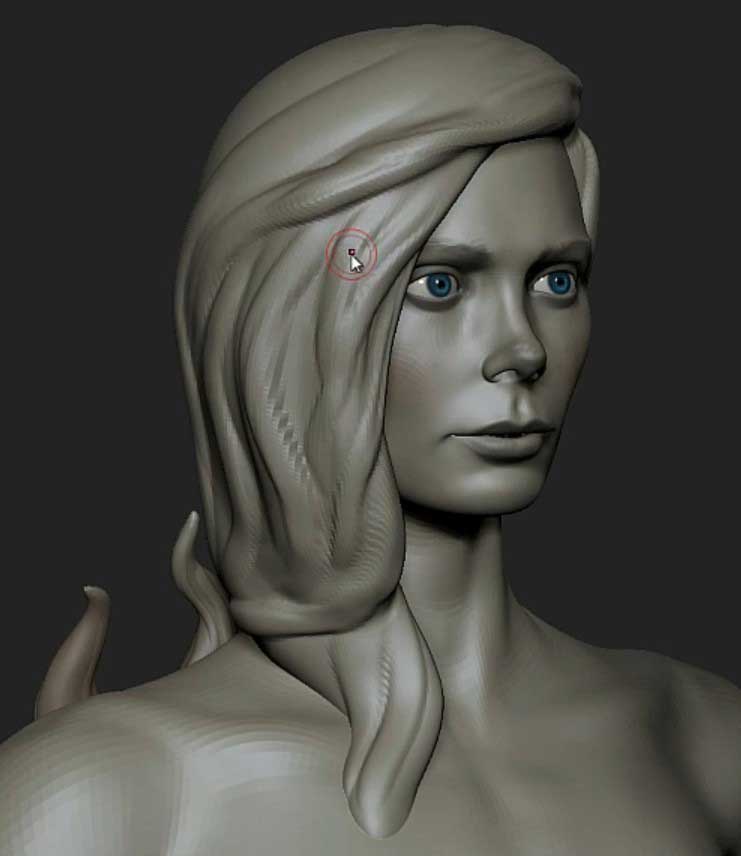 There will be a lot of back-and-forth process when sculpting hair. By Henning Sanden
There will be a lot of back-and-forth process when sculpting hair. By Henning Sanden
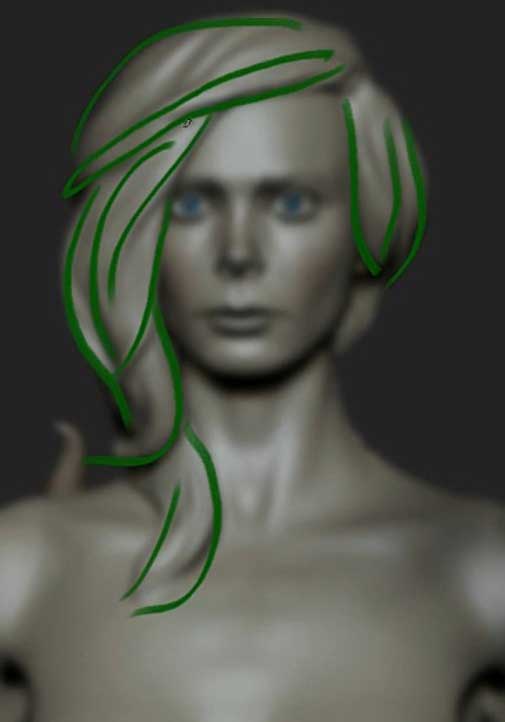 It just works! By Henning Sanden
It just works! By Henning Sanden
Tertiary Details
The Tertiary Details; this pass could be more time-consuming, but I gotta say if the previous passes have gone as you would like, this is the fun part. The Tertiary Details define, well, the tiny details like single hair strands, and the fly-away hairs added on the silhouette. This pass is also supposed to add more randomness and breakups to the hair.
Another important aspect of this pass could be on the hairlines. The way hair touches the head may not look good/natural until this step. You have to try to add more single strands/lower-count chunks of hair to where the hair meets the scalp. This is a huge step to the realism, which most artist either forget, or don’t pay too much attention.
-
If you’re doing real-time hair, you need your texture sheet to have a few hair groups made of low[er] counts of hair strands. Since every piece of hair card you add matters, choose the placement of the details carefully (as always, have an eye on the reference). Also pay attention to the transition of hairlines as it’s often in real-time hairs that hairlines looks so unnatural. Again, you can read more about creating game hair texture sheet, here.
-
If you’re using hair-groomers like XGen, you’ll probably need at least two descriptions, depending on your workflow. One for the hairlines, and one for the fly-away hairs and little details here and there.
-
If you’re sculpting, you just need to make your audience “feel” the material of the hair. You don’t always have to do every single hair strand, it’s almost impossible (not totally, it just needs tons of time!) in some ways. Choose the placement and the size of your strokes carefully.
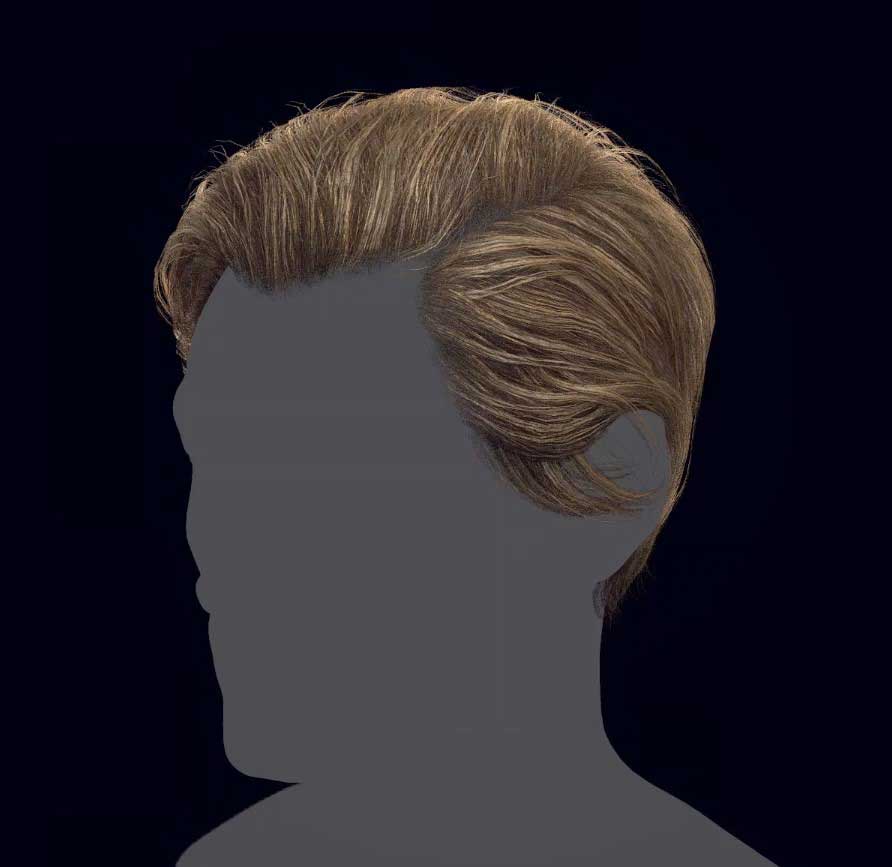 Final game hair by Adam Skutt
Final game hair by Adam Skutt
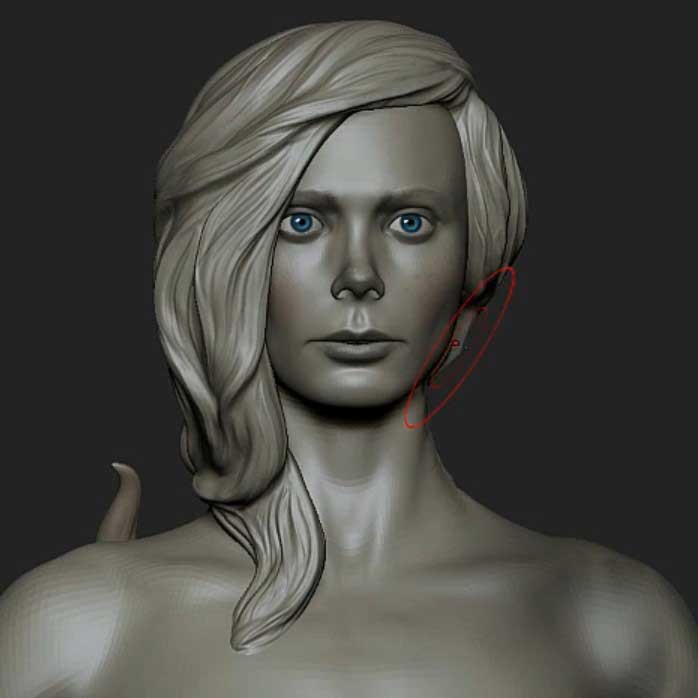 This sculpture is stylized, but you still can see pretty well that how tertiary details are executed when sculpting. By Henning Sanden
This sculpture is stylized, but you still can see pretty well that how tertiary details are executed when sculpting. By Henning Sanden
Studying The References
As always, it’s crucial to gather a bunch of references for the hairstyle you’re going for. A way of quickly studying you references would be to open them in Photoshop, and trying to determine the Primary Forms, the Secondary Shapes and the Tertiary details by doing some paint-overs.
When studying, have that blur trick in mind. Blur you reference image, and draw on the main lines you see. That will be the Secondary Shapes. Whatever not noticeably visible, is in the Tertiary Details pass.
Also by doing so, you can -for example- have an idea of how many hair groups you need in your texture sheet for you real-time hair.
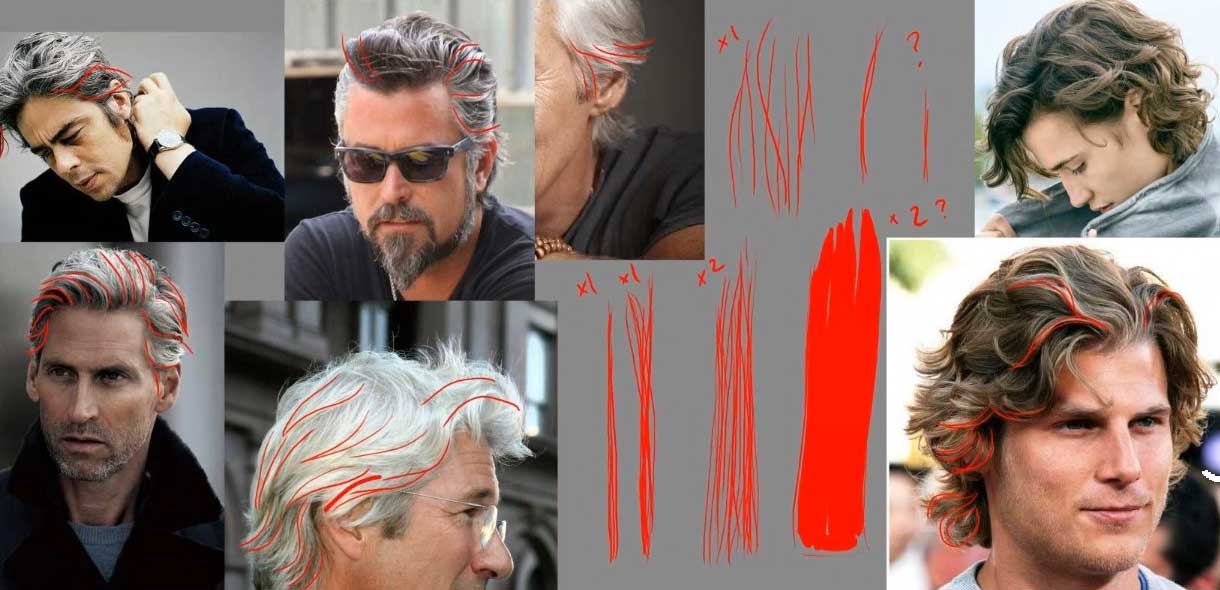 Reference study by Adam Skutt
Reference study by Adam Skutt
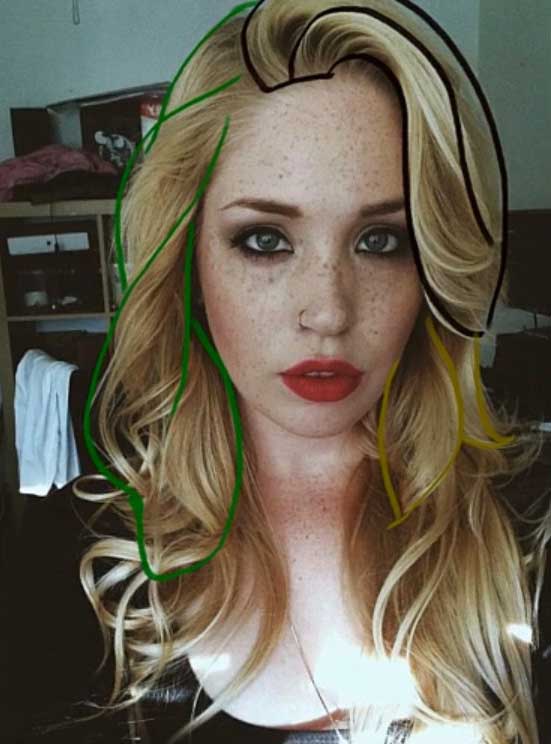 Reference study by Henning Sanden
Reference study by Henning Sanden
Conclusion
Note that the passes I talked about, are not totally separated processes and could be a back-and-forth workflow between them, which in most cases, it is. For example, you may need to adjust the Primary Forms while doing the Secondary Shapes. Just take your time, and don’t stick with what you already have. Don’t be afraid of changing, to be able push your art to the next level.
That’s it guys. I hope I was clear in explanation of the concept of breaking down the steps of doing all sorts of hairs. I’ll be happy to hear from you guys.
Cheers!